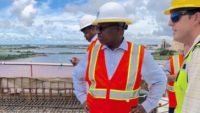...win the war. “Is discipline having a perfectly creased uniform and shining your shoes?” asks Lt. Nate Rawlings, the executive officer of E Company, 1-22 Infantry, whose soldiers routinely patrol ten hours a day outside the wire, searching for improvised explosive devices (IEDs). “There are tons of people here—eighty percent—who don’t even know there’s a war going on. There’s guys who have flaks (protective body armor) hanging in their offices and the last time they put them on was when they flew in. At the beginning there was no wire, so everyone was mission-focused. Now there’s tons of people who never leave the wire and so you have to treat them differently.”
 |
| The post exchange boasts a full selection of the latest movies and video games. (Photo courtesy of Whitney Terrell) |
What Might Have Been
Still, having so much comfort, safety or infrastructure are problems that most Iraqis would love to have. It is hard not to see in the Liberty-Victory complex a glimpse of what the reconstruction might have been. After all, if $200 million can build, power, and clean a city the size of Independence, Mo., then why hasn’t the $18.4 billion appropriated to Iraq’s reconstruction produced, say, 92 cities of comparable worth? One obvious answer is security—the work done at Liberty-Victory goes on free of any fear of attack. But this alone doesn’t seem to be enough to justify the disparity in outcomes. One notable difference between the Victory Liberty Directorate of Public Works (DPW) and the Project Contracting Office, which oversaw much of Iraq’s early reconstruction, is the former’s relative lack of bureaucracy. The entire department fits in an office that is roughly the size of a double-wide trailer, and the major sections of its operation are over seen by just three men: Cpt. Wischmann is the utilities chief, which puts him in charge of all potable water, sewage, and electricity. Major Anthony Streletz heads the engineering plans and construction, while Major Christian A. Sulit takes care of buildings and grounds, along with terrain management. Another has been consistency of command. Since the U.S. Army Corps of Engineers created the office, only two units have been in charge: a Puerto Rican Army Reserve unit, which ran the operation from June of 2004 to August of 2005, when they were replaced by Cpt. Wischmann and his fellow officers.
Cpt. Wischmann says his accomplishment during this time has been his oversight of the base’s two major powerplants, which he describes as being “in infancy” when his team arrived. The first plant had been completed in 2004, the result of a partnership between the Army and Al-Hamara, an Iraqi firm with a good reputation in the U.S., according the Cpt. Wischmann. The second plant, known as the IAP plant, was built by International American Products, which leases its electricity back to the U.S. military. This summer marks the first time that both plants have been on line and operating at peak capacity—a significant achievement in a country where reliable power is hard to find. “We don’t know how long we’re going to be here,” Capt. Wischmann says. “So we intend to turn the plants over to the Iraqis if they’ll pay for it or we’ll take it back —either by ourselves or give it back to IAP.”
It’s an appealing idea, this concept of handing back to the Iraqis a pre-fabricated city, complete with its working powerplants, its thousands of glistening white trailers, its fire stations, hospitals and repossessed palaces. If you climb “Antenna Hill,” the only piece of raised ground in the complex, which is covered, as its name would suggest, by a porcupine’s nest of radio receiving equipment, what you see below is the basic American blueprint of the suburbs—the very thing that Independence became back in the 1950s, when Harry Truman sold his farm to create the area’s first suburban shopping mall. There are the trailers, and hardball roads, and loading docks and Jersey barriers, and grayish, big top tents spread out like strip malls amid vast gravel parking lots filled with Chevy suburbans. It is no accident, perhaps, that Cpt. Wischmann attended Central Missouri State University, or that Major Sulit grew up in Shawnee Mission—which is, like Independence, a suburb of Kansas City.
And yet one wonders if this new, imported American suburbia might not end up being —for Iraqis at least—a mirage every bit as exotic as the tigers that Saddam kept on the hunting grounds that once had been housed here. Especially given the fact that these same Iraqis, off in the darkness on the distant horizon, don’t tend to live in air-conditioned trailers, but rather thatch roofed huts close to the corn and hay fields that they tend to make their living. And that no one seems quite sure where these farmers would find $200 million to buy the city back, much less the $100 million a year it takes to run the complex currently.
“What I don’t understand are those people on TV who say we’re going to have a complete withdrawal in two years,” says the soldier who has driven me to the hilltop. “We’re never leaving this place . . . I don’t see anything getting built that isn’t absolutely necessary for operation -- bridges, roads, bases. I don’t see us building hospitals. I see us building super bases like this.” And then, as he tries to drive his humvee back to camp, he finds the road blocked by a gang of foreign workers—Filipinos, to judge from their accent—who are laying in new drainage pipe.


Post a comment to this article
Report Abusive Comment